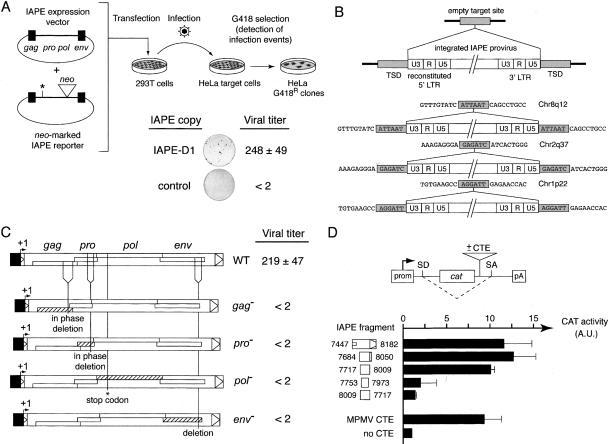Figure 4.
Infectivity and functional characterization of IAPE-D1 and mutant derivatives. (A) Rationale of the infectivity assay and viral titer of IAPE-D1. 293T cells were cotransfected with an expression vector for the wild type (see Fig. 3A) or mutant IAPE-D1 derivatives (or pCMV-β as a control) and a neo-marked defective IAPE reporter. Supernatants from the transfected cells were collected 48 h post-transfection and used to infect HeLa target cells. After a 3-d growth period, infection events were detected upon G418 selection of the cells, and viral titers were quantified by counting the number of G418R clones per milliliter of supernatant (mean values ± SD, n = 3). (B) Structure of de novo integrated IAPE proviruses. The complete characterization of integrated IAPE elements and their insertion sites was performed using individual HeLa clones obtained after infection and G418 selection. A provirus insertion and the corresponding empty, pre-insertion site are schematized at the top, with the sequences of three characterized IAPE de novo insertions shown below. Target-site duplications of 6 bp (TSD, light gray) are found in all cases, associated with reconstituted 5′-LTRs. (C) IAPE genes required for infection. Infectivity assays were performed with either the wild-type IAPE-D1 copy or the same element rendered defective for gag, pro (via in-frame deletions, from nucleotides 1909–2313 and from nucleotides 2876–3139, respectively), pol (via introduction of a stop codon at nucleotide 3802), or env (via an out of frame deletion from nucleotide 7194–7453). The number of G418R clones obtained per milliliter of supernatant for each construct is indicated. (D) Rationale of the assay and evidence for CTE activity in IAPE-D. The reporter vector contains a cat gene flanked by splice donor and acceptor sites (SD and SA) placed under the control of a simian virus 40 promoter (prom) and polyadenylation signal (pA), and sequences to be tested for CTE activity are inserted as indicated. The presence of a CTE should promote the export of unspliced RNAs from the nuclei of cells transfected with the reporter plasmid, leading to a detectable chloramphenicol acetyltransferase (CAT) activity, whereas the absence of a CTE-like activity should lead to the export of spliced RNA and no CAT activity. 293T cells were transiently transfected with the reporter vector containing the indicated IAPE fragments, placed in the forward or reverse orientation (numbers indicate the nucleotide positions of the 5′- and 3′-ends of each fragment in the IAPE sequence). Forty-eight hours post-transfection, cells were lysed, and CAT activity was determined as described in Methods. The mean ratio of CAT activity between the reporter vector containing an IAPE sequence (or a control MPMV CTE) versus the empty vector (no CTE) was calculated from two to four independent experiments (A.U., arbitrary units; error bars indicate standard deviation).

